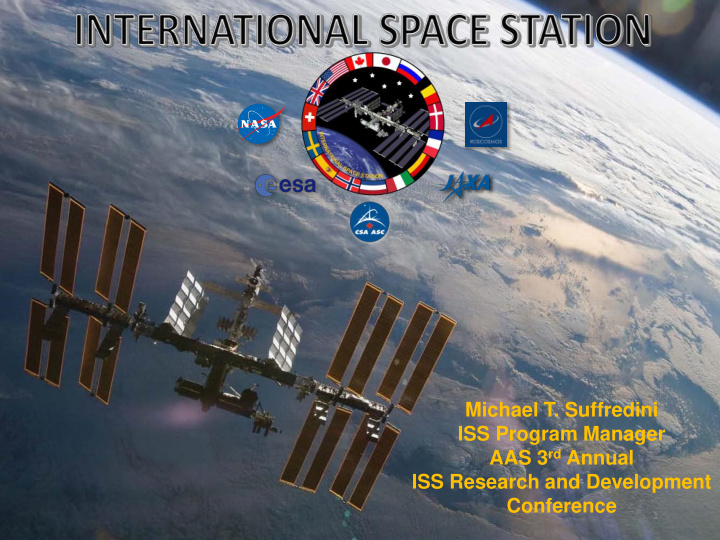



Michael T. Suffredini ISS Program Manager AAS 3 rd Annual ISS Research and Development Conference 1
Research Highlights of the Past Year Number of Investigations Expedition 0-36: 1556 Earth sensing Pharmaceutical/medical/biological Materials 33/34 35/36 37/38 Crew Time (hrs/wk) 38 40 43 # Investigations 217 217 201* # New Inv. 51 41 42* * Prelim. numbers, subject to change. Education Exploration/Fundamental Research 2
Research Capability Upgrades External • Earth pointing platform • Exposure platforms • Deployment capabilities for CubeSat and larger payloads Internal • Rodent, drosophila , cell, and plant research • On orbit analysis • Additional glovebox
ISS Infrastructure Upgrades Recent Upgrades Upcoming Additions • Additional S/G channels to enable • KU forward link provides payloads PI’s to talk to the crew • commanding capability via Increased ability for high quality video downlink standard internet protocols (Jan • Increased data down/uplink 2015) • Command and telemetry capability • Delay Tolerant Network (Mar using internet protocols via Stella (IP encapsulation) 2015) • Additional video downlink channels • Web-based access enabling simultaneous payload ops • • 4 th crew to increase crew time to 110 VAC power interface for COTS products average 68.5 hours per week • Higher quality cameras to take • High def video of external ISS advantage of increased downlink capability from multiple locations (pan, tilt, • External wireless access zoom, still images)
ISS Extension 4 crew (2017) Assembly Complete (2011) 3 crew (2009) 4 crew (2017) Goals Implications • Enable the development of a commercial • 4 th crew for 4 more years market in LEO 3 crew means an additional 25000+ (2009) • Return benefits to humanity hours of crew time • Complete investigations to reduce human • 10 years to demonstrate the health and performance risk for long value for commercial and duration deep space missions non-government users • Mature technology for spaceflight beyond • Simplify and shorten LEO template for payload • Provide basis for international exploration developers cooperation
Commercializing LEO ISS as a platform is available to • Determine what works and what doesn’t • Gather data to make a business case As soon as a commercial approach becomes available, NASA will move our research to the commercial platform
Inverting the Focus Evolving from the Program as the Customer to the Investigator NOW > FUTURE Single Customer Effort Investigator input into customer input multiple processes with distributed redundant data within Program Investigator Investigator schedule centered timeline driven by on payload NASA defined, development launch date- Program Effort schedule focused milestones Approved research Approved research experiment experiment
Upcoming Opportunities Business Opportunities via Science Opportunities CASIS • CASIS • Biomedical – Any funded research can take – Drug mechanisms advantage of ISS at any time – Protein structures – Pathfinder research announcements to – Innovation incubators prime new areas of research of commercial interest • Earth Observation • Earth remote sensing, materials science, • Industry partnerships stem cells – Smart materials • NASA solicits for research in many – Technology demonstration areas and development – Astrophysics, Earth science • Education partnerships instruments, Life Sciences/Space Biology, Human research and exploration risk, GeneLAB – omics • Data acquisition/sharing – HICO hyperspectral data, life sciences data archive, physical science informatics database
Limitations and Synergies More investigations more likely to max out resources Synergies that can maximize To ensure you aren’t caught by utilization with limitations of these limits in your research, resources think about • • Sample sharing Crew Time – Biospecimen sharing program – Automation or ground operated – Sharing blood draws or other – Combining related experiments collection of human samples • Upmass/Downmass • Data sharing and archiving – In situ analysis to redirect – GeneLAB, Physical Science research in real time and reduce Informatics, Life Science Data dependence on return samples Archive – Minimize numbers of samples – Data archives for Earth and and runs space observational instruments • Data • Hardware sharing – Internal data recorders, batch • International collaboration files for download, DTN, downlink at varying rates Next few increments will be tight for crew time while we reconfigure ISS to support 4 crew.
Summary • ISS is healthy and still has capacity for growth • The ISS Program continues to work with our customers to reduce integration time and increase flexibility…while flying safely • ISS life extension now provides 10 years of on orbit time to utilize ISS and establish a business case for commercial viability in LEO • CASIS is increasing commercial use of ISS • ISS reconfiguration to support commercial crew will challenge crew time for research in the next few increments , but ultimately increases research capability • Together we are advancing research in and commercialization of LEO for the benefit of all. 10
Recommend
More recommend